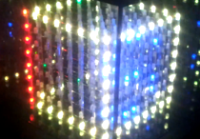Infinite RGB LED Cube with Flowcode

By Ben RowlandAfter being inspired from the Xmas tree blog post I started looking around at what other people were doing and I came across a simple single colour 8x8x8 LED Cube project on Instructables.
By Ben Rowland
After being inspired from the Xmas tree blog post I started looking around at what other people were doing and I came across a simple single colour 8x8x8 LED Cube project on Instructables.
The post was great and looked simple enough so I thought I would have a go at it myself as well as making a Flowcode component to allow me to simulate and easily develop programs for any size of LED cube. I planned on a larger single colour version of the cube but then realised that to double the display meant potentially quadrupling the number of LEDs and connections required and so scaled down my thinking a bit and instead went for the RGB LED approach. This then went further and I thought up a way of making it a useful enough item that I could get away with installing into my living room. Being inspired from infinity mirrors made into tables on YouTube I thought what about we box up the LED cube with glass and mirrored car window tint and create an infinity cube. Installed onto the center of a nice largish second hand coffee table, I might just get away with that one ;)
A step-by-step guide is detailed below, as contributions... more to come!
For convenience sake, all reference files and additional downloads can be found in the main site (here), and not inside the contributions.
--
Coming soon...
We will look into creating some animations to display on the cube using the Flowcode component and look into scripting techniques to allow us to control this via the Flowcode 6 simulation using USB communications or via a file located on an SD card.
--
Videos:
- Simple test routine driven from a ECIO40P
- Basic animations using Flowcode v6



Discussion (7 comments)